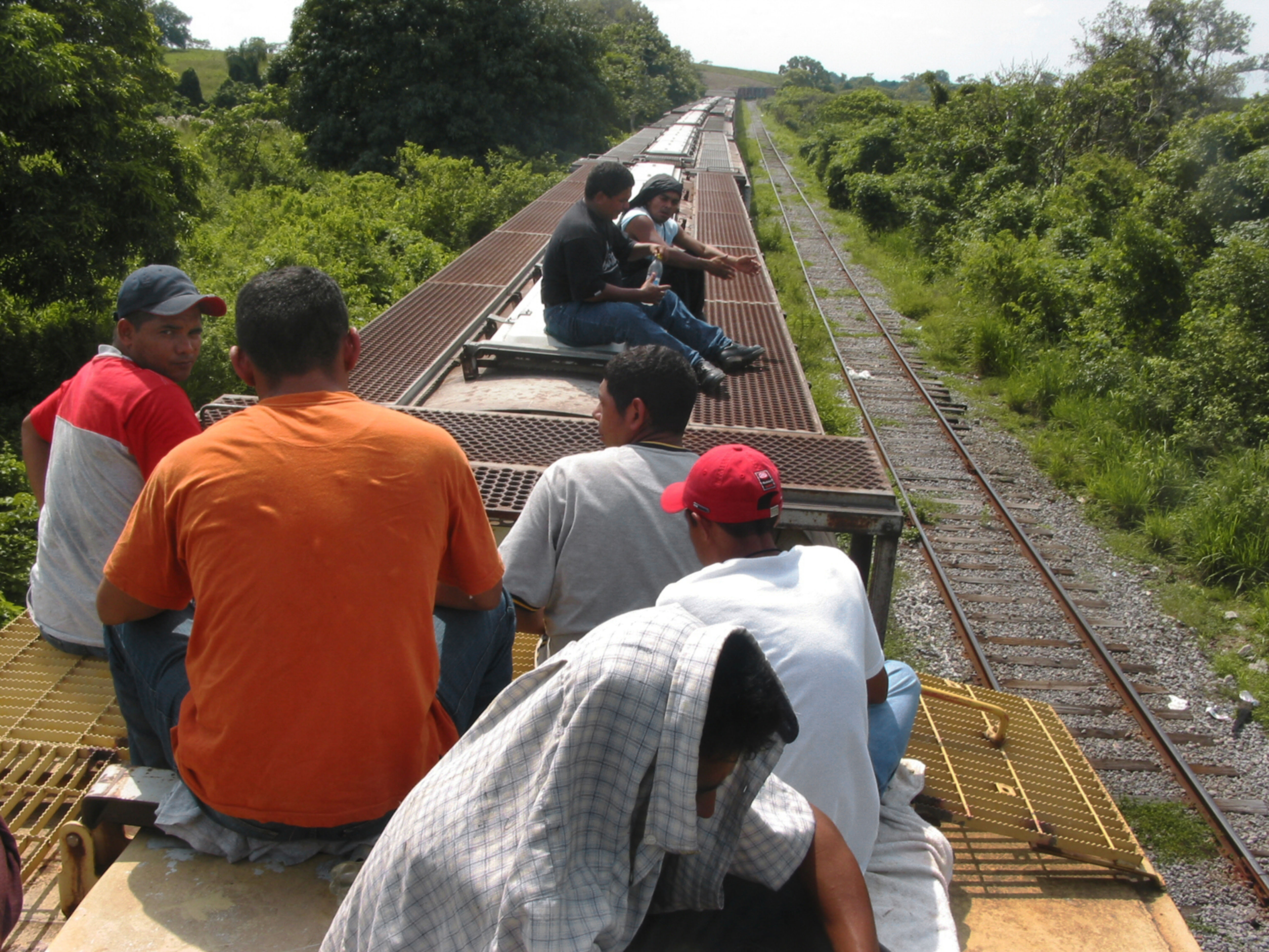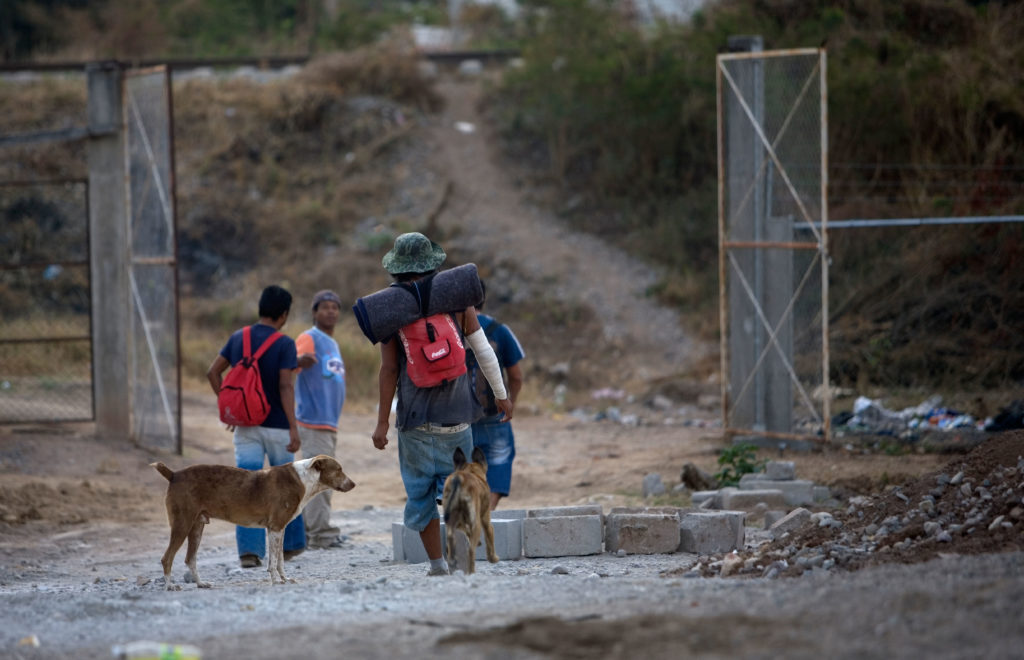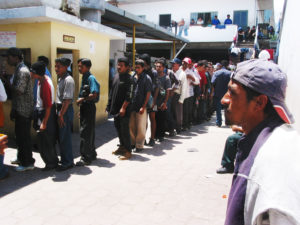Mexican cartels prey on migrants from Central America
University of Texas report suggests Federal Police adopt ‘international best practices’ to protect migrants

Each year, hundreds of thousands of migrants who enter Mexico from three Central American countries are at risk of rape, kidnapping, robbery, extortion, violence and murder at the hands of Mexico’s criminal cartels.
The transnational syndicates act essentially as highwaymen, abusing and plundering Central Americans migrating north. About 350,000 of these migrants enter Mexico annually, many on their way to the U.S. border.
For the cartels, the biggest moneymaker is a toll fee, or “piso,” that criminals force migrants to pay to continue traveling. The criminals also kidnap and hold them until the victims’ family members pay a ransom. They compel them to cultivate cartel marijuana or poppy fields, or simply rob and brutalize them.
Others are compelled to act as “mules” to smuggle drugs – such as marijuana stuffed inside backpacks, or “mochilas” – to earn money to pay for passage by the cartel’s human traffickers across the U.S. border.
For Mexico’s understaffed Federal Police, the challenge of combating these crimes is hard enough. However, making it more taxing are recent Mexican laws directed at ensuring the safety and sheltering of vulnerable migrants. The laws generally block police from detaining migrants for questioning and even prevent them from arresting migrants suspected of committing crimes, frustrating efforts by officers to investigate and capture offending cartel members.

In hopes of solving this complex problem, the Federal Police asked the LBJ School of Public Affairs at the University of Texas at Austin to perform a study and suggest strategies to safeguard migrants from Mexico’s predatory cartels without violating the country’s strict statutes to protect the innocent.
The LBJ School released its report, Organized Crime and Central American Migration in Mexico, in June. It found that the syndicates – typically associated with drug trafficking such as the Sinaloa, Los Zetas and Gulf cartels – earn an estimated $134 million annually from crimes against migrants.
“Migrants traveling through Mexico are frequently subjected to serious human rights violations,” the researchers stated. “Organized criminal groups in Mexico regularly interact with and victimize migrants. These criminal activities are often predatory in nature and in many cases include rape, kidnapping, or murder.
“Despite a federal legal framework designed to protect irregular migrants in Mexico, responsible agencies have failed to prevent crimes against migrants and have at times actively participated in their victimization.”
Female migrants, who are subject to sexual assault by cartel criminals, may also end up victimized by “coerced survival sex” whereby “they are forced by, a smuggler, a police officer, migration official or another migrant to exchange sex for shelter, protection, food or the ability to proceed.”
These immigrants emerge from the “Northern Triangle” nations of Central America – Guatemala, El Salvador and Honduras – that endure poverty and unstable political environments as well as poor government and police control over violent criminal gangs (including El Salvador’s MS-13 and 18th Street gang) that threaten the common people. The three nations are the most impoverished in Latin America. The poverty rate in Honduras is 66 percent. The large number of migrants from Central America “fleeing violence and poverty appears unlikely to slow down in the future,” the researchers said.
On their way north, the migrants typically hop trains, walk along train tracks, highways and roads, or use cars, trucks, buses and, at times, airplanes. Too often, they run into the same routes cartel gangsters use to traffic narcotics to the United States.
The numbers of these migrants traveling through Mexico, based only on those the police encounter, is enormous, presenting a crisis for Mexican federal and local law enforcement. In 2015 and 2016, Mexico captured more than 350,000 of them, and the actual number could be as much as 400,000, according to the University of Texas.
Migrants ordered by the cartels to pay the “piso” fork over an average of $400 per person, which the University of Texas estimates brings in about $96 million for the cartels per year. The syndicates and other “predatory smugglers” generate $20 million annually from kidnapping migrants and extorting victims’ relatives for ransoms averaging $5,165 per migrant.

Independent or cartel-connected crooks known as “dishonest human smugglers” will offer to sneak migrants into the United States for a fee of $4,270, on average, but take off with the funds, abandoning the victims in Mexico. Smugglers earn an estimated $17 million annually from reneging on their deals.
Meanwhile, migrants also must contend with local bandits and “maras,” gang members from Central America (such as MS-13) who offer assistance to the Mexican cartels. The migrants lose about $60 each, or $1.2 million a year, from robberies.
Criminal bands, which in some ways resemble small armies, most frequently abuse migrants on Mexico’s southern and northern borders and in the east along the Gulf of Mexico, less so on the west coast. Groups associated with the Los Zetas and Gulf cartels encounter them on the Gulf of Mexico corridor and with the Sinaloa cartel on the western side.
The university report comes at a time of continued chaos in Mexican society. Politicians, local judges, police forces and the military face daunting challenges in battling Mexico’s chaotic organized crime problem. In the first half of 2018, the nation recorded more than 11,240 syndicate-linked murders, an all-time high and on pace to surpass the full-year record of nearly 24,900 homicides in 2017, according to the Mexican reformist consulting group Semaforo Delictivo.
From last September, when Mexico’s political season began, to this past June, 132 of the country’s politicians were assassinated, including 48 political candidates. Meanwhile, Mexico’s total police force, at about 330,000 officers, is inadequate and overworked, with the average officer making only $1.78 an hour and logging about 48 hours per week, according to Mexican government statistics.
Federal Police attempting to apprehend cartel criminals who target migrants have to follow two major laws that complicate their efforts. One is a federal law that guarantees foreign migrants the same full rights of citizenship granted to Mexican citizens.
Another is the Migratory Law of 2011, a statute intended to provide humanitarian and legal assistance to migrants. Under this law, Federal Police may not ask migrants to verify their migratory status or arrest or detain them, even those who are criminal suspects. Instead, the law requires officers to turn over migrants to an agency called the National Migrant Institute (NMI). The police have to help the NMI’s agents – who are unarmed – confirm legal standing and shield migrants from further exploitation. When migrants with the NMI need armed security, the Federal Police must provide it.
The NMI offers living quarters, food, medical and other assistance. Migrants have the right to due process of law and the ability to lodge complaints against officers as do citizens of Mexico. However, by prohibiting Federal Police from even arresting migrants who may have committed crimes at the behest of Mexican organized crime, the Migratory Law can complicate or hinder criminal investigations of the cartels and the migrants themselves.
Another hurdle for Federal Police – not mentioned in the LBJ School report – is that some local police and NMI officials themselves have been implicated in victimizing migrants for money. Authorities in 2011 arrested six NMI agents who allegedly dropped off 120 migrants with the Gulf Cartel, which then held them hostage for ransom, according to the news website InSight Crime. The arrests led the Mexican government to terminate the heads of INM offices in seven Mexican states.
As for what the Federal Police should do, to start with, the University of Texas report recommends that the force adopt “international best practices for police treatment and protection of migrants” similar to those used in Europe, Africa and Asia. The university cites coordination by Europol, the International Criminal Police Organization (Interpol), the Association of Southeast Asian Nations (ASEAN) and some African nations. The groups organize joint operations against human traffickers and smugglers. The Texas researchers further advised that the Federal Police and other Mexican agencies form migrant task forces with law enforcement in Honduras, Guatemala and El Salvador.

Federal Police, they said, also should set up a office for Mexico and its southern neighbors of the Northern Triangle to share information, modeled after Europol’s European Migrant Smuggling Center. The center uses an international organization, the Secure Information Exchange Network that trades messages with law enforcement, analysts and government officials to make intelligence available on smuggling suspects.
Mexico could devise an inter-agency database for Federal Police and other Mexican agencies, patterned after Europol’s Mobile Analysis Support Teams that deploy intelligence officers to detect and intercept suspected human smugglers, including those using social media, or engaging in “e-smuggling.”
Federal police and immigration agents of the National Migrant Institute, the university wrote, should undertake Europe’s human rights-based approach (HBA) toward migrants, whereby law enforcement places the “life, liberty, and dignity of migrants ahead of immigration enforcement.”
Mexico also might emulate the European Union Agency for Fundamental Rights, which has published a best practices guide for community policing and training that incorporates human rights for migrants in everyday police activities.
Finally, to address crimes against migrants, the university said the Federal Police should expand its knowledge of migrant smuggling trends, similar to a joint operation known as Project Relay. In that project, a team including Interpol, Canada and several Asian countries, successfully put together a sophisticated criminal database, assessed what it needed to gather intelligence, conducted training classes and installed communications equipment it required. Mexico should also consider using digital “i-maps” technology that pinpoints migration patterns to find out where to send officers to block criminals from harassing migrants.
Feedback or questions? Email blog@themobmuseum.org





